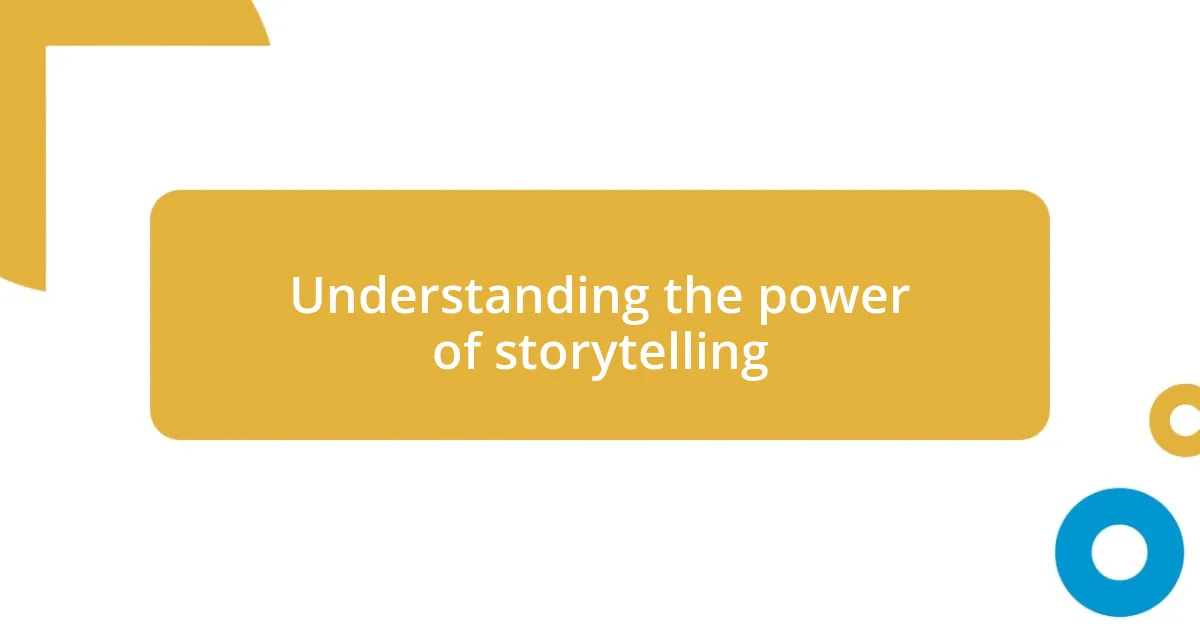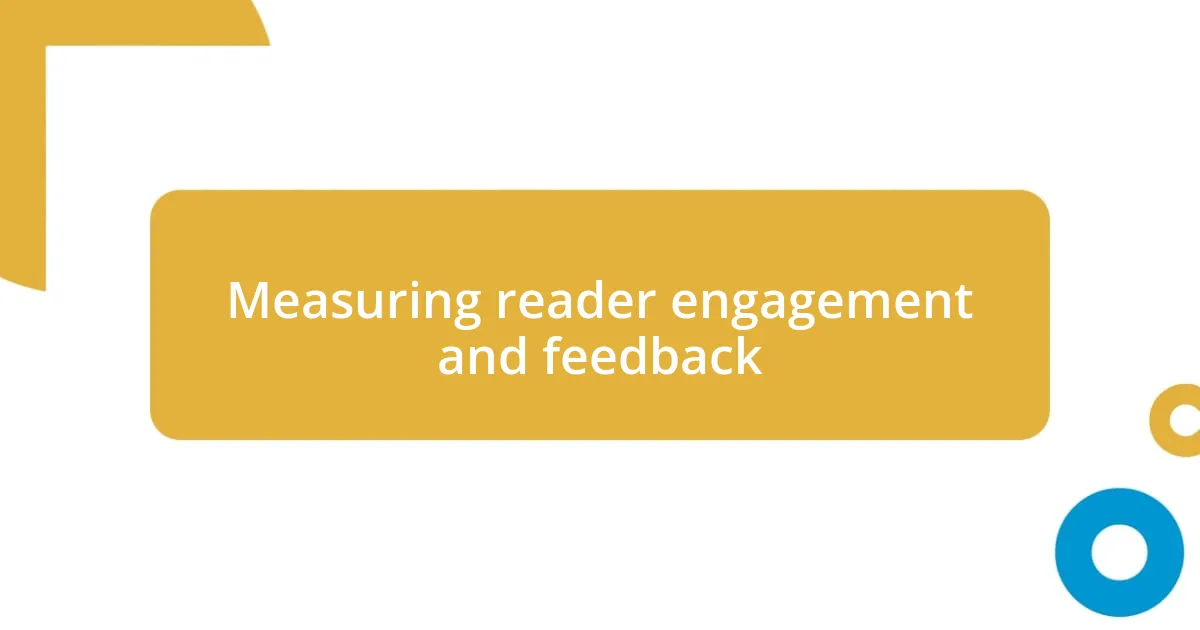Key takeaways:
- Storytelling evokes emotions, creates connections, and helps in memory retention, making it a powerful tool for engaging readers.
- Identifying your target audience is crucial for tailoring narratives that resonate with their experiences and feelings.
- Incorporating relatable characters, balanced pacing, and strong themes enhances narrative impact, encouraging deeper emotional investment from readers.
- Measuring reader engagement through metrics and direct feedback allows writers to understand how their stories resonate and improve their craft.

Understanding the power of storytelling
Storytelling has an incredible ability to evoke emotions, making it a powerful tool in engaging readers. I remember reading a novel that transported me to a different world, immersing me in the characters’ struggles and triumphs. Have you ever felt an intense connection to a story that kept you awake at night? That’s the magic of storytelling—it resonates on a deeply personal level.
When we connect through stories, we often find ourselves relating to experiences that might not even mirror our own. I often reflect on how a simple tale of resilience from a stranger can inspire courage in my own life. Isn’t it fascinating how stories can bridge gaps between diverse experiences and create shared understanding?
Additionally, storytelling helps us remember information better. For instance, when I attended a workshop where the speaker concluded with a poignant personal story, not only did I grasp the concepts he taught, but I found myself recalling that story long afterwards. Isn’t it true that a well-told story can stick with us far longer than a list of facts ever could? It’s this unique blend of emotion and memory that underscores the immense power storytelling wields in engaging readers.

Identifying your target audience
To truly connect through storytelling, identifying your target audience is a crucial step. When I first began my journey in writing, I realized that not every story resonates with everyone. Understanding who you’re speaking to helps tailor your narrative to evoke the right emotions and reflections. Knowing your audience means you’re not just telling a story; you’re creating a dialogue that speaks directly to their experiences and feelings.
Here’s a quick guide to help identify your audience:
- Analyze demographic data: What age group are they in? What are their interests?
- Consider their preferences: Do they prefer humorous tales or serious narratives?
- Reflect on their challenges: What problems do they face that your story could address?
- Engage with them directly: Use social media polls or surveys to gather insights about what they enjoy.
By taking these steps, you’re setting yourself up to craft stories that truly resonate, making your audience feel seen and heard. I’ve found that when I take the time to understand my readers, my storytelling becomes more impactful and enriched with shared experiences.

Crafting a compelling narrative
Crafting a compelling narrative begins with a strong foundation of relatable characters and a vivid setting. I remember drafting a story where the protagonist mirrored some of my own challenges. I infused authentic emotions into his journey, and that clarity allowed readers to connect with him on a personal level. When characters feel genuine, readers invest their time and emotions into the narrative, making each twist and turn more meaningful.
Another crucial element is the pacing of the story. I’ve always found that balancing action with quieter moments can heighten tension and engagement. For example, in one of my short stories, I included a suspenseful chase scene immediately followed by a reflective moment in solitude. This rhythmic ebb and flow kept my readers on the edge of their seats while also allowing them time to digest the emotional weight of the journey. Isn’t it fascinating how the tempo of a story can influence our connection to it?
Lastly, I believe that a well-defined theme serves as the backbone of a compelling narrative. It’s the message that resonates after the final page is turned. In my own writing, I’ve explored themes of love and loss, weaving them through characters’ lives. Each crafted phrase serves to highlight these underlying messages, ensuring readers leave with something to ponder long after the story ends. Isn’t the thought of having a lasting impact on someone through your narrative an inspiring notion?
| Element | Description |
|---|---|
| Characters | Genuine and relatable, driving emotional connections. |
| Pacing | Balancing action with reflection to maintain interest. |
| Theme | The core message that lingers in the reader’s mind. |

Utilizing emotional triggers effectively
Utilizing emotional triggers effectively means tapping into the feelings that resonate with your audience. When I was crafting a narrative about friendship lost to misunderstandings, I specifically drew on my own experiences of betrayal. I remember the gut-wrenching feeling of being let down by someone I trusted. By describing that pain, I found that many readers reached out, sharing their own stories of heartbreak. It’s incredible how a shared emotional experience can create a strong bond between the writer and reader.
One trick I’ve learned is to incorporate sensory details to enhance emotional responses. For instance, while writing a scene about joy, I vividly described the warmth of the sun on skin, the sound of laughter ringing in the air, and the taste of sweet cake being shared among friends. By appealing to the senses, I help readers feel as if they’re right there with the characters, experiencing the highs and lows firsthand. Isn’t it powerful how such small details can amplify the emotional resonance of a story?
Moreover, using contrasting emotions allows for deeper engagement. In my writing, I often juxtapose moments of joy with sudden despair, mirroring the unpredictability of life itself. One story I wrote shifted from a peaceful day in the park to a sudden accident that changed everything. This unexpected turn made readers pause and reflect on their own lives—how everything can pivot in a heartbeat. Doesn’t that make you think about the complexities of our own experiences and relationships? By embracing this emotional volatility, I found stories become not just tales, but profound explorations of human existence.

Incorporating vivid imagery and details
When I think about incorporating vivid imagery and details, I often recall a scene I wrote set in a bustling marketplace. As I described the vibrant colors of the stalls—reds, yellows, and greens bursting under the afternoon sun—I could almost hear the vendors calling out their wares. Those details transformed a simple setting into a lively backdrop, allowing readers to visualize the chaos and excitement. Have you ever walked through such a place and felt your senses come alive?
Utilizing metaphors can also breathe life into my storytelling. In one of my more experimental pieces, I compared a character’s grief to a thick fog, enveloping her in a weight that made every breath feel heavy. This not only conveyed the emotional depth of her loss but also painted a picture that lingered in the reader’s mind. It’s fascinating how a well-placed image can convey complex feelings, isn’t it?
Additionally, I find that drawing from my own experiences adds authenticity to my descriptions. For example, when I wrote about a cozy winter evening, I described the way the cold air nipped at my cheeks as I rushed inside to the inviting warmth of a crackling fireplace. Those tiny moments resonate deeply and create a sense of nostalgia, allowing readers to connect with the feelings evoked by those details. Doesn’t it feel wonderful to be transported to a memory simply through words?

Engaging readers through dialogue
Engaging readers through dialogue can be a powerful way to draw them into your narrative. I remember crafting a conversation between two characters who had been estranged for years. With every word they exchanged, I felt the tension and unspoken feelings leap off the page. It was as if I could hear their voices, filled with regret and hope, echoing my own struggles with forgiveness. Have you ever been part of a conversation that changed everything? That’s the kind of impact dialogue can have.
One thing I’ve learned is the importance of using dialogue to reveal character traits. In a recent piece, I portrayed a witty protagonist whose humor often masked deep insecurities. Through his sarcastic banter, I showed readers not only his charm but the layers of vulnerability beneath. When readers see characters come to life through their words, they become more invested in their journeys. Doesn’t it make you feel closer to them when you understand their struggles so intimately?
Moreover, the rhythm of dialogue can drive the pacing of a story. I’ve experimented with short, clipped exchanges to create tension in dramatic moments. During a pivotal scene where a secrets are unveiled, I noticed how a rapid back-and-forth led to palpable suspense. Readers were glued to the page, eager to see how the conversation would unfold. Isn’t it fascinating how a few well-placed words can transform the reader’s experience?

Measuring reader engagement and feedback
Measuring reader engagement often hinges on looking at tangible metrics as well as qualitative feedback. I’ve found that tracking data, such as time spent on a page or scroll depth, gives me a glimpse into how invested readers are in the story. For instance, when I noticed a particular chapter was receiving unusually high engagement, it made me eager to delve deeper into what resonated with readers in that part—was it a pivotal plot twist or an emotional revelation?
Feedback can also come through comments and discussions, which I relish. It’s like having a conversation with my audience after they’ve absorbed my story. I remember when a reader posted about how a character’s journey mirrored their own life experiences. That connection brought me so much joy, reminding me of the power of storytelling to evoke personal reflection. Have you ever shared a piece of writing and received a response that completely surprised you? It’s moments like those that reinforce the importance of measuring engagement beyond just numbers.
Additionally, I have learned to use surveys and polls to directly ask readers how they felt. I once created a simple poll after a serialized story, asking which character they felt most connected to and why. The responses opened my eyes to perspectives I hadn’t considered before, adding another layer to my understanding of my audience. It’s amazing how a few targeted questions can lead to deeper insights, isn’t it?














